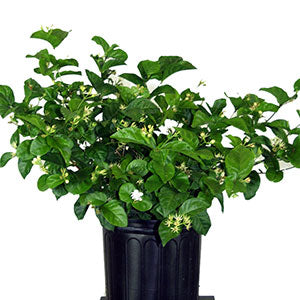Jasmine (Jasminum sp.)
Jasmine Plant Features
It's easy to fall in love with jasmine and its glorious, sweet fragrance. A lovely group of vines and shrubs, there are many different types of jasmine, meaning there's probably a perfect one for your garden! Almost all have pure white flowers that are graced with a light, sweet fragrance.In frost-free areas, most varieties are evergreens that have dark green leaves. Shrubby types are excellent for growing as low flowering hedges, foundation plants, or in garden beds and borders with other shrubs, annuals, and perennial flowers. Climbing jasmine vines are often grown on trellises and fences. No matter which type you grow, be sure to plant it someplace that you can enjoy its wonderful fragrance.
While most jasmine varieties are best as outdoor plants, there are a few that can be good houseplants, flowering on and off throughout the year if they get enough light. But to bloom well, they need a bright spot.
Jasmine Questions?
Send our gardening experts an email and we'll get back to you!
Jasmine Growing Instructions
Grow jasmine in full sun or partial shade. While these flowering shrubs and vines will tolerate a lot of shade, they don't bloom nearly as much.Water jasmine when the soil starts to dry out. Established plants are somewhat drought tolerant but grow best when they receive regular water during dry spells. Jasmine grown in containers needs more frequent watering because its large root system can quickly fill up a container.
Jasmine plants in the landscape typically don't need fertilization as they're able to get the nutrients they need from the soil. If you grow them in pots or would like them to flower more (or have poor or sandy soil), you can fertilize monthly in spring and summer with a general-purpose fertilizer. Be sure to follow the directions on the packaging in regards to how much fertilizer to use and how often to use it.
Pruning jasmine depends on what type you have. Typically, most types that do a big display of flowers once a year can be pruned right after they've finished blooming. Prune the jasmines that bloom year-round in spring and lightly through the year as necessary.
Jasmine is not recommended for human or animal consumption.
-
Water
Medium water needs
-
Light
Indoors: High light
Outside: Part sun
Outside: Sun
-
Colors
White
-
Special Features
Attracts butterflies
Fragrant flowers/foliage
Complement your Jasmine
MandevillaGrow jasmine and red mandevilla together for a beautiful, classic look.
Allamanda
Jasmine's small white flowers add an elegant touch to allamanda.
Copperleaf
Give copperleaf a fun touch by accenting its bold foliage with beautiful jasmine blooms.



